 Most viewed Most viewed |

fundbud1.pdfFundamentals of Buddhism7347 viewsThe basic teachings outlined here include: the Life of the Buddha, the Four Noble Truths, the Noble Eightfold Path, Karma, Rebirth, Dependent Origination, The Three Universal Characteristics and The Five Aggregates. Dr Santina also puts Buddhism into its context by describing the pre-Buddhist background and gives an overview of Buddhism from a modern perspective in a very readable way.
|
|

buddha_life_01.gifThe Royal Wedding7219 viewsThe Royal Wedding
|
|

children.pdfLove Your Children the Right Way7208 viewsI composed this book when I was in Chiang Mai, where I lived for 10 years. In my work there, I observed many parents who had children but knew nothing about how to raise there beloved children properly so that they would grow to be good citizens of the nation. When I thought about this matter, I started writing an article concerning parents responsibility in raising their children - Panyananda Bhikkhu.
|
|

wheel-deer.jpgDharma Wheel Deer7108 viewsTibetan Buddhist Art Work: Dharma Wheel Deer
|
|

ele_pali.pdfElementary Pali Course7067 viewsThis Elementary Pali Course by the late Venerable Narada Thera, the renowned Buddhist scholar of the Vjirarama Vihara, Colombo, Sri Lanka, is the standard work for the study of the elementary level of Pali. Pali was the language spoken by the Buddha, and employed by him to expound his teachings. It is also the scriptural language used by the Theravada school of Buddhism.
|
|

3_teach.pdfThree Teachings7027 viewsTenzin Palmo's Teachings on Retreat, Mahamudra and Mindfulness are a delight to read. Transcribed from talks she gave in Singapore in May 1999, the teachings are delivered in plain language, seasoned with plenty of audience participation. Each subject is discussed with humour, liveliness and compassion. She has the great gift of showing how to put the Dharma into every part of our everyday lives. Born in London in 1993, Tenzin Palmo traveled to India and was ordained as a Buddhist nun in 1964. Her 12-year retreat in a cave high in the Himalayas, described in the book 'Cave in the Snow', focused international attention on the role of women and their spirituality in the Buddhist context.
|
|

prajparagen2.pdfThe Diamond Sutra6960 viewsThis sutra says, One should produce a heart without dwelling anywhere. The Sixth Patriarch, the Great Master Hui, heard that sentence and awakened to the Way. Any dwelling of the heart is no dwelling. Therefore, the Larger Chapters say, If one dwells in dharmas, he does not dwell in prajna paramita. If one does not dwell in dharmas, he dwells in prajna paramita. That is why every one of the Great Prajna assemblies begins with an explanation of not dwelling.
|
|

mahasit1.pdfPractical Vipassana Exercises6942 viewsThe late Mahasi Sayadaw was responsible for the modern revival of Vipassana or Insight meditation in Myanmar (Burma). This text is his basic instruction on the practice: the preparatory stages with a series of basic exercises. Part two, deals with the deals with the progressive practice and the practical vipassana exercises. The appendix explains the techniques involved in the Mahasi Sayadaw tradition.
|
|

1lotus04.jpgSacred Lotus 046911 viewsTibetan Buddhist Art Work: Sacred Lotus 04
|
|

Aggregates.pdfA Burden Off the Mind: A Study Guide on the Five Aggregates6832 viewsOne of the new concepts most central to the Buddha's teaching was that of the khandhas, usually translated into English as “aggregates.†Prior to the Buddha, the Pali word khandha had very ordinary meanings: A khandha could be a pile, a bundle, a heap, a mass. It could also be the trunk of a tree. In his first sermon, though, the Buddha gave it a new, psychological meaning, introducing the term “clinging-khandhas†to summarize his analysis of the truth of stress and suffering. Throughout the remainder of his teaching career, he referred to these psychological khandhas time and again. Their importance in his teachings has thus been obvious to every generation of Buddhists ever since.
|
|
| 1212 files on 122 page(s) |
 |
 |
4 |  |
 |
 |
 |
|
